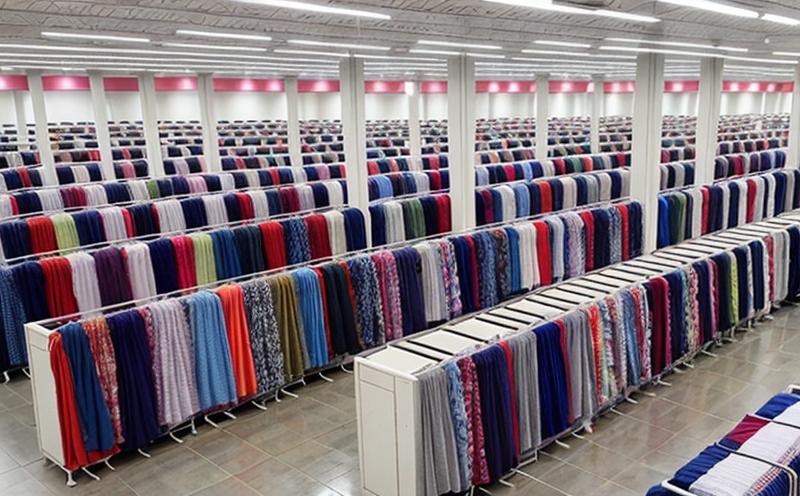EN 14682 Safety of Children’s Clothing Cord Testing for Exports
The European Standard EN 14682:2013 sets stringent requirements to ensure the safety of children's clothing, particularly focusing on cords and drawstrings. This standard aims to prevent potential hazards such as strangulation or entanglement that can arise from overly long or improperly secured cords and drawstrings.
The testing under EN 14682 involves assessing several critical parameters related to the length, strength, and security of cords used in children's clothing. The primary goal is to ensure that these components do not pose a risk when worn by young children. Compliance with this standard is mandatory for exports to European Union member states and other regions that adopt it as an official requirement.
According to EN 14682, the test involves the following steps:
- Cord Length Measurement: The maximum length of cords must not exceed 350 mm. This measurement is taken from the garment when worn by a mannequin simulating the posture of an active child.
- Cord Strength Testing: The cord should withstand a minimum tensile force without breaking, ensuring it remains securely attached to the garment.
- Drawstring Security Check: Drawstrings must not be easily accessible and should have a secure fastening mechanism that prevents them from becoming loose or unraveling during normal wear.
The testing process is critical for manufacturers exporting children's clothing, as non-compliance can lead to significant issues. These may include product recalls, damage to brand reputation, and even legal penalties in the importing country. Ensuring compliance with EN 14682 not only protects consumers but also ensures market access.
Furthermore, this standard aligns with broader international safety standards such as ASTM F1357-19 and IEC 62390, which are used in various jurisdictions around the world. Compliance with these standards is crucial for manufacturers aiming to export their products globally.
In summary, EN 14682 is a vital standard that ensures children's clothing is safe from potential hazards related to cords and drawstrings. It is essential for quality managers, compliance officers, R&D engineers, and procurement teams to understand the requirements and implications of this standard when dealing with exports.
Eurolab Advantages
At Eurolab, we offer comprehensive services that cater specifically to the needs of manufacturers looking to comply with EN 14682. Our state-of-the-art facilities and experienced team ensure accurate and reliable testing results.
- Expertise in Compliance: Our laboratory is staffed by experts who are well-versed in international standards, including EN 14682.
- Accurate Testing Equipment: We use the latest equipment to conduct precise measurements and tests as per the standard's requirements.
- Prompt Reporting: We provide quick turnaround times for test results, ensuring that you can make informed decisions promptly.
- Comprehensive Support: Our team offers guidance on specimen preparation, documentation, and any other aspects of compliance.
Choosing Eurolab means accessing the most up-to-date facilities and expert knowledge. We understand the importance of meeting international standards for your business's success in exporting to Europe and beyond.
Why Choose This Test
The EN 14682 test is crucial for ensuring the safety of children’s clothing, especially considering that young children are more vulnerable to accidents. By adhering to this standard, manufacturers can significantly reduce the risk of hazards such as strangulation or entanglement.
Here are some key reasons why you should choose this test:
- Market Access: Compliance ensures market access to major European markets and other regions that recognize EN 14682.
- Risk Mitigation: By identifying potential hazards early, manufacturers can mitigate risks before they become significant issues.
- Reputation Protection: Ensuring product safety enhances brand reputation and customer trust.
- Legal Compliance: Meeting the standard avoids legal penalties and product recalls.
In a competitive global market, meeting international standards is not just advisable but necessary. Eurolab’s EN 14682 testing service helps you stay ahead of regulations and ensure your products are safe for children.
International Acceptance and Recognition
- Australia: While Australia does not adopt this standard, many importers from the country require compliance with international safety standards like EN 14682 for children's clothing exports.
- Canada: Canadian regulations are influenced by European standards, making compliance with EN 14682 beneficial for exports to Canada.
- New Zealand: New Zealand also recognizes European safety standards, including EN 14682. Compliance can help avoid product rejections and delays at customs.
- Japan and South Korea: Although these markets have their own standards, manufacturers often choose to comply with multiple international standards like EN 14682 for broader market access.
In summary, while some countries may not officially require compliance with EN 14682, many importers and regulatory bodies expect it as a standard of safety. Ensuring your products meet this requirement can significantly enhance your global market presence.





